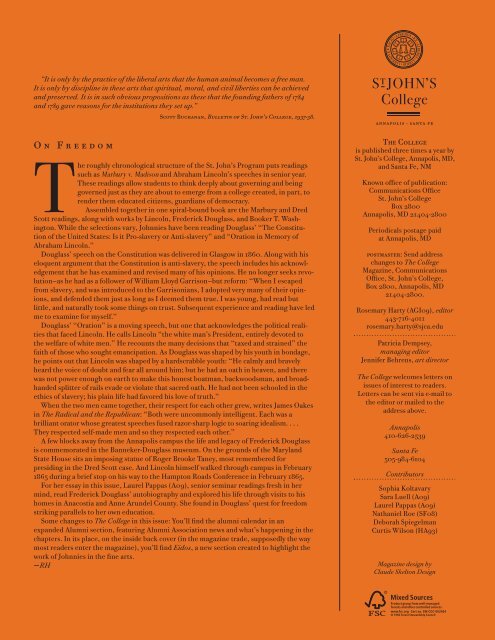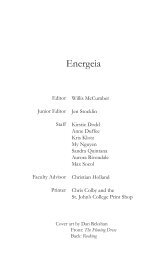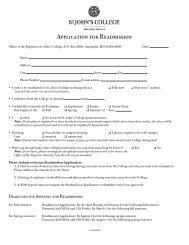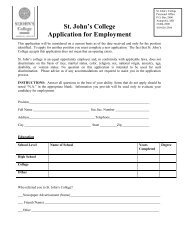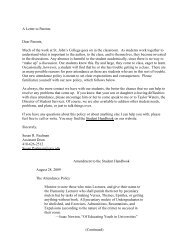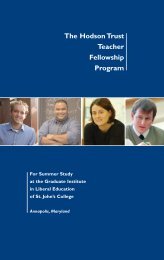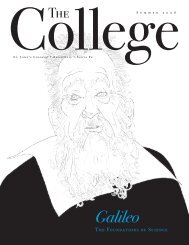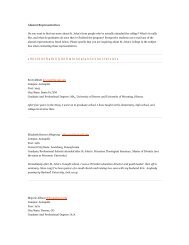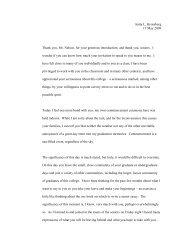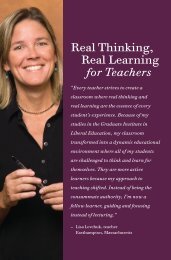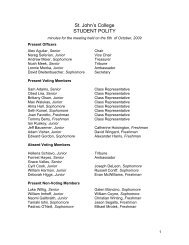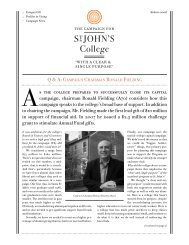Frederick Douglass - St. John's College
Frederick Douglass - St. John's College
Frederick Douglass - St. John's College
Create successful ePaper yourself
Turn your PDF publications into a flip-book with our unique Google optimized e-Paper software.
“It is only by the practice of the liberal arts that the human animal becomes a free man.<br />
It is only by discipline in these arts that spiritual, moral, and civil liberties can be achieved<br />
and preserved. It is in such obvious propositions as these that the founding fathers of 1784<br />
and 1789 gave reasons for the institutions they set up.”<br />
Scott Buchanan, Bulletin of <strong>St</strong>. John’s <strong>College</strong>, 1937-38.<br />
On Freedom<br />
The roughly chronological structure of the <strong>St</strong>. John’s Program puts readings<br />
such as Marbury v. Madison and Abraham Lincoln’s speeches in senior year.<br />
These readings allow students to think deeply about governing and being<br />
governed just as they are about to emerge from a college created, in part, to<br />
render them educated citizens, guardians of democracy.<br />
Assembled together in one spiral-bound book are the Marbury and Dred<br />
Scott readings, along with works by Lincoln, <strong>Frederick</strong> <strong>Douglass</strong>, and Booker T. Washington.<br />
While the selections vary, Johnnies have been reading <strong>Douglass</strong>’ “The Constitution<br />
of the United <strong>St</strong>ates: Is it Pro-slavery or Anti-slavery” and “Oration in Memory of<br />
Abraham Lincoln.”<br />
<strong>Douglass</strong>’ speech on the Constitution was delivered in Glasgow in 1860. Along with his<br />
eloquent argument that the Constitution is anti-slavery, the speech includes his acknowledgement<br />
that he has examined and revised many of his opinions. He no longer seeks revolution—as<br />
he had as a follower of William Lloyd Garrison—but reform: “When I escaped<br />
from slavery, and was introduced to the Garrisonians, I adopted very many of their opinions,<br />
and defended them just as long as I deemed them true. I was young, had read but<br />
little, and naturally took some things on trust. Subsequent experience and reading have led<br />
me to examine for myself.”<br />
<strong>Douglass</strong>’ “Oration” is a moving speech, but one that acknowledges the political realities<br />
that faced Lincoln. He calls Lincoln “the white man’s President, entirely devoted to<br />
the welfare of white men.” He recounts the many decisions that “taxed and strained” the<br />
faith of those who sought emancipation. As <strong>Douglass</strong> was shaped by his youth in bondage,<br />
he points out that Lincoln was shaped by a hardscrabble youth: “He calmly and bravely<br />
heard the voice of doubt and fear all around him; but he had an oath in heaven, and there<br />
was not power enough on earth to make this honest boatman, backwoodsman, and broadhanded<br />
splitter of rails evade or violate that sacred oath. He had not been schooled in the<br />
ethics of slavery; his plain life had favored his love of truth.”<br />
When the two men came together, their respect for each other grew, writes James Oakes<br />
in The Radical and the Republican: “Both were uncommonly intelligent. Each was a<br />
brilliant orator whose greatest speeches fused razor-sharp logic to soaring idealism. . . .<br />
They respected self-made men and so they respected each other.”<br />
A few blocks away from the Annapolis campus the life and legacy of <strong>Frederick</strong> <strong>Douglass</strong><br />
is commemorated in the Banneker-<strong>Douglass</strong> museum. On the grounds of the Maryland<br />
<strong>St</strong>ate House sits an imposing statue of Roger Brooke Taney, most remembered for<br />
presiding in the Dred Scott case. And Lincoln himself walked through campus in February<br />
1865 during a brief stop on his way to the Hampton Roads Conference in February 1865.<br />
For her essay in this issue, Laurel Pappas (A09), senior seminar readings fresh in her<br />
mind, read <strong>Frederick</strong> <strong>Douglass</strong>’ autobiography and explored his life through visits to his<br />
homes in Anacostia and Anne Arundel County. She found in <strong>Douglass</strong>’ quest for freedom<br />
striking parallels to her own education.<br />
Some changes to The <strong>College</strong> in this issue: You’ll find the alumni calendar in an<br />
expanded Alumni section, featuring Alumni Association news and what’s happening in the<br />
chapters. In its place, on the inside back cover (in the magazine trade, supposedly the way<br />
most readers enter the magazine), you’ll find Eidos, a new section created to highlight the<br />
work of Johnnies in the fine arts.<br />
—RH<br />
The <strong>College</strong><br />
is published three times a year by<br />
<strong>St</strong>. John’s <strong>College</strong>, Annapolis, MD,<br />
and Santa Fe, NM<br />
Known office of publication:<br />
Communications Office<br />
<strong>St</strong>. John’s <strong>College</strong><br />
Box 2800<br />
Annapolis, MD 21404-2800<br />
Periodicals postage paid<br />
at Annapolis, MD<br />
postmaster: Send address<br />
changes to The <strong>College</strong><br />
Magazine, Communications<br />
Office, <strong>St</strong>. John’s <strong>College</strong>,<br />
Box 2800, Annapolis, MD<br />
21404-2800.<br />
Rosemary Harty (AGI09), editor<br />
443-716-4011<br />
rosemary.harty@sjca.edu<br />
Patricia Dempsey,<br />
managing editor<br />
Jennifer Behrens, art director<br />
The <strong>College</strong> welcomes letters on<br />
issues of interest to readers.<br />
Letters can be sent via e-mail to<br />
the editor or mailed to the<br />
address above.<br />
Annapolis<br />
410-626-2539<br />
Santa Fe<br />
505-984-6104<br />
Contributors<br />
Sophia Koltavary<br />
Sara Luell (A09)<br />
Laurel Pappas (A09)<br />
Nathaniel Roe (SF08)<br />
Deborah Spiegelman<br />
Curtis Wilson (HA93)<br />
Magazine design by<br />
Claude Skelton Design


